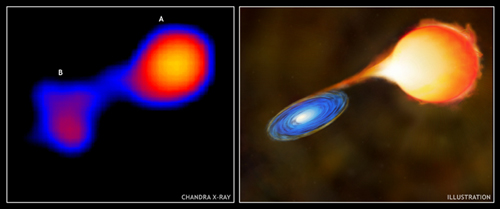Mira: A double star system 420 light years from Earth
Caption: Chandra's image shows Mira A (right), a highly evolved red giant star, and Mira B (left), a white dwarf. To the right of the image is an artist's conception of this interacting star system. Mira A is losing gas rapidly from its upper atmosphere via a stellar wind. Mira B exerts a gravitational tug that creates a gaseous bridge between the two stars. Gas from the wind and bridge accumulates in an accretion disk around Mira B and collisions between rapidly moving particles in the disk produce X-rays. An unexpected X-ray outburst from Mira A was observed by Chandra. This outburst was likely an indirect consequence of the internal turmoil in Mira A, which is now approaching the stage where its nuclear fuel supply will be exhausted. It will eventually collapse to become a white dwarf, like Mira B.
Scale: X-ray image is 1.2 arcsec per side.
Chandra X-ray Observatory ACIS Image
|


